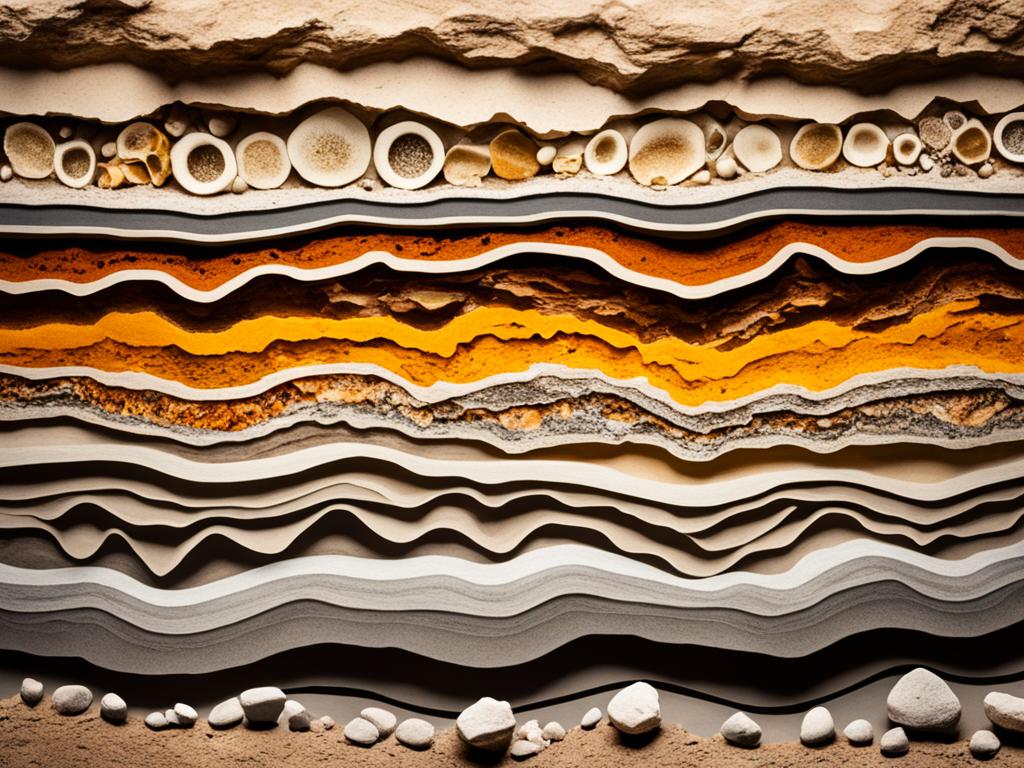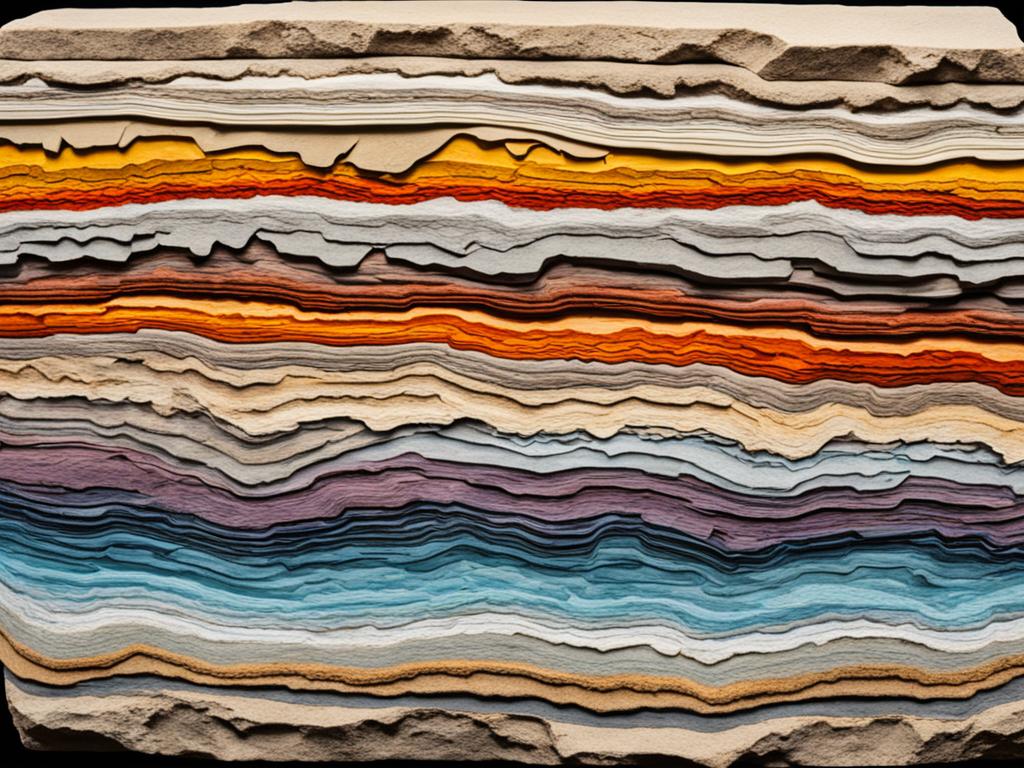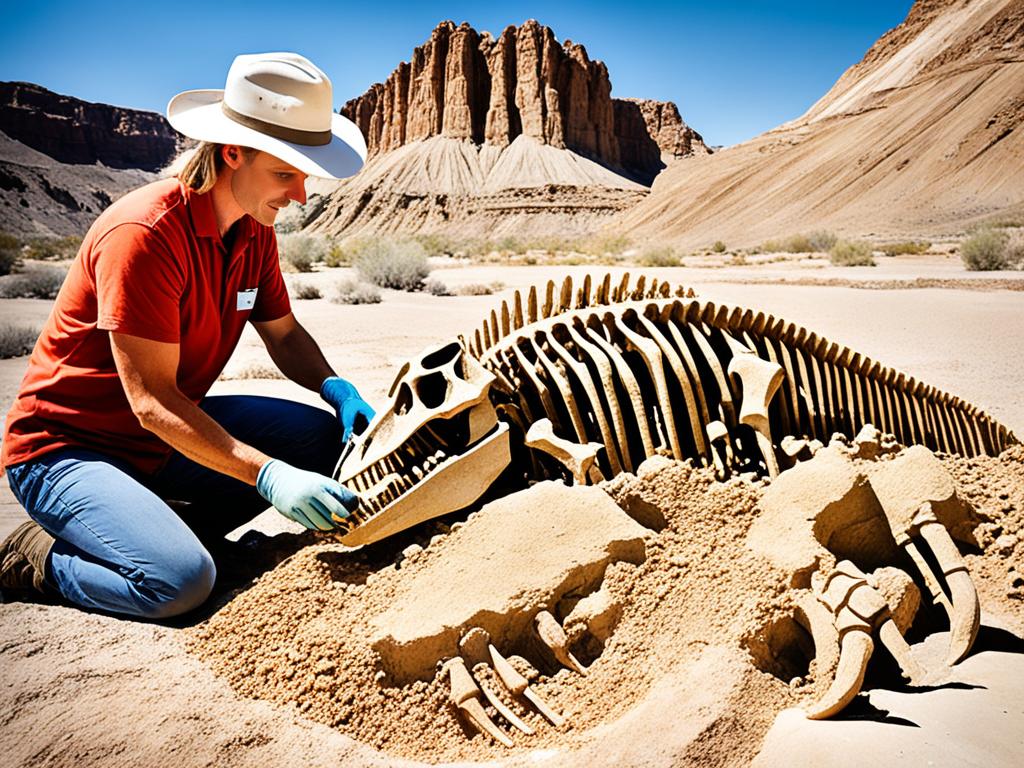Fossils are the preserved remains of plants and animals. These were buried in things like sand and mud under ancient water sources. This means they can tell us a lot about the past.
Fossils are not just bones. They can be anything that shows how life used to be, more than 10,000 years ago. Things like bones, shells, teeth, and even footprints can keep for thousands of years. Soft parts often go away, but what’s left behind can be replaced by minerals. This turns into rock, keeping the old shape of life.
Fossils tell us about how things have changed over time. They help us see how life has adapted to its surroundings. This is important for understanding the story of life. It’s like a big family tree of all living things.
Because different fossils end up in different kinds of rocks, we can learn a lot about the earth’s past this way. Fossils are mostly found in rocks made from layers of sediments, but there are a few ways they can be saved. Things like compression, permineralization, and mold and cast formation let us see ancient life’s impressions.
Key Takeaways
- Fossils are often found in sedimentary rocks and give us a glimpse of ancient life.
- They show how life changed and adapted over long periods, supporting evolution theories.
- Fossils in rocks of different kinds help us date them and tell the story of the earth’s past.
- It’s not common for organisms to fossilize. Most times, they just break down after death, especially the soft parts.
- There are two main types of fossils: body fossils like bones, and trace fossils like footprints.
Introduction to Fossils
Fossils are the remains or marks of ancient life, including plants, animals, and tiny life forms. They come in the form of bones, shells, footprints, and even petrified feces. By studying fossils, we learn about the past, including how life has changed over time.
Defining Fossils
Fossils are the remains or imprints of long-gone life forms. These can be parts of bodies like bones or teeth. They can also include signs of life, such as tracks or fossilized waste.
Importance of Fossil Studies
Paleontology, or the study of fossils, is key to knowing Earth’s life history. Fossils show how species have changed and what the past environment was like. They help us see big events, like when many species vanished, and understand life’s journey on Earth.
Types of Fossils
Fossils are unique forms that tell us about life’s history on Earth. They come in two main types: body fossils and trace fossils.
Body Fossils
Body fossils are the actual remains of ancient organisms. They can be bones, shells, teeth, and more. These fossils let scientists directly study who these ancient creatures were.
Hard parts, like bones and shells, can last a long time in rocks. That’s why we often find them when looking at fossils.
Trace Fossils
Trace fossils show us how ancient creatures lived. They include footprints, burrows, and even fossilized feces. These traces give clues about their movements and lives.
Microfossils and Macrofossils
Fossils are not just big; they can be very small. Microfossils are tiny, like pollen and single-celled creatures. Macrofossils, like big bones and shells, can be seen without a microscope.
Both micro- and macrofossils help in understanding Earth’s long history. They tell us about life’s changes over millions of years.
Fossil Formation Process
Fossils are remains of ancient plants and animals. They show us the Earth’s past. Fossil formation happens in different ways. Each way makes a unique kind of fossil.
Permineralization
In permineralization, minerals replace the original material. This turns it into rock. When an organism is buried, fluids move through the ground. They fill the empty spaces in the remains with minerals like calcite or silica.
Compression
Compression fossils form under heat and pressure. This happens from covering sediments. Often, the result is a dark, flattened imprint of the organism. Many plant fossils are formed this way.
Molds and Casts
Sometimes, the shell or bone of an organism dissolves. This leaves a space, shaped like the original. Sediments fill this space, creating a cast of the fossil.

Fossils and Evolution
Fossils are key in proving the theory of evolution. They show how organisms’ physical traits have changed over time. The fossil record reveals when species started or disappeared. It also shows the development of new traits, which supports the theory of evolution by natural selection.
Evidence of Evolution
The fossil record allows us to look into the past. It shows the progression of life on Earth. Scientists can see how organisms changed over a long time by looking at fossil traits and distribution.
This helps support the theory of evolution. Fossils bear witness to how species gradually changed. They show forms that link older and newer species, which proves the idea of common ancestry.
Fossil Record and Evolutionary Trees
The fossil record helps create evolutionary trees. These trees show the relationships and branching patterns between different species over time. By looking at the fossils’ similarities and differences, scientists can understand how species evolved and how life developed on Earth.
These evolutionary trees visually show how species are related. They illustrate how life has changed through speciation, adaptation, and extinction events.
Fossils: What They Tell Us About Earth’s History
Geological Time Scale
Fossils are vital for creating the geological time scale. This scale breaks Earth’s history into eras, periods, and epochs. It’s based on the organisms found in different time periods. By studying when different fossil organisms lived, geologists can figure out the age of rock layers. They can then match these rock layers from different places.
Ancient Environments
Fossils help us learn about the past’s environmental conditions, like the weather and the land. They show what kind of life lived in these areas. Through the study of fossils, we can imagine how ancient environments looked and changed over time.
Prehistoric Life
Fossils give us a window into the many life forms that existed long ago. This includes dinosaurs, marine animals, and even tiny plants. By examining these remains, scientists can learn a lot about how life on Earth developed.
| Relevant Statistical Data | Value |
|---|---|
| Sedimentary rocks commonly contain fossils of shells and shell fragments | Due to their hardness, which favors preservation |
| Common fossils include hard parts like bones, teeth, eggs, wood, leaves, shells, corals, and microfossils | These materials are more likely to be preserved than soft tissues |
| Various types of fossils exist, including trace fossils (ichnofossils) that preserve evidence of an organism’s activities | Trace fossils provide insights into the behaviors and interactions of ancient life forms |
| The fossil record is incomplete and biased, with certain organisms being poorly represented | This reflects a bias towards organisms with hard shells and skeletons, which are more likely to be preserved |
| Fossils mostly form in sedimentary rocks through processes like sediment accumulation and mineral precipitation | These processes are crucial for the fossilization and preservation of organic remains |
| Observations suggest that the fossilization process can occur relatively quickly, ranging from a few hours to a few years | This highlights the importance of rapid burial and mineralization for effective fossil formation |
| Fossils provide insights into past life forms regarding size, shape, locomotion, diet, behavior, and ecological relationships | By studying fossil characteristics, scientists can reconstruct the features and adaptations of ancient organisms |
| The geological record shows a consistent sequence of fossils in layers, potentially supporting theories like Ecological Zonation | The predictable distribution of fossils in rock layers can reveal patterns of environmental change and species succession |
| The fossil sequence does not directly imply evolutionary change, with Darwinian theories facing challenges in explaining certain features | The abrupt appearances of diverse animal forms, such as during the Cambrian Explosion, pose difficulties for some evolutionary models |
Fossil Dating Techniques
Fossils help us know how old rocks are. There are different ways to date them, like biostratigraphy and radiometric dating. By looking at the fossils and where they are, we can tell how old the rock layers are. This helps us understand Earth’s history better.
| Dating Technique | Time Range |
|---|---|
| Radiocarbon Dating | 1 – 70,000 years |
| K-Ar Dating | 1,000 – billions of years |
| Uranium-Lead Dating | 10,000 – billions of years |
| Uranium Series Dating | 1,000 – 500,000 years |
| Fission Track Dating | 1,000 – billions of years |
| Luminescence Dating | 1,000 – 1,000,000 years |
| Electron Spin Resonance (ESR) Dating | 1,000 – 3,000,000 years |
| Cosmogenic Nuclides Dating | 1,000 – 5,000,000 years |
| Magnetostratigraphy Dating | 20,000 – billions of years |
| Tephrochronology Dating | 100 – billions of years |
These dating methods help scientists figure out the age of rocks. They look at the fossils in the layers of rock to learn about Earth’s past. It’s like a time machine to study history.

Fossil Preservation
Some places are better for fossils to last a long time. These include spots where things were buried quickly in sediments, there’s not much oxygen, and fluids with lots of minerals are around. This setup keeps things from rotting away, making it more likely they turn into fossils.
Favorable Environments
Oceans and seas are great places for fossils to stay well. Things get covered fast by sand or mud, keeping them safe from harm. This fast covering step is key to keeping all the details of the fossil intact.
Rapid Burial
Being buried quickly in sediments is essential for making a fossil. It stops the remains from breaking down and keeps their features sharp. For instance, when a tree turns into stone because minerals replaced its soft parts, we learn a lot about the Earth’s past.
Fossils and Extinction
The fossil record shows us many big events where lots of species disappeared quickly. These events have greatly shaped life on Earth over time. They show how life can change a lot in a short time.
Mass Extinction Events
The Cretaceous-Paleogene (K-T) event got rid of dinosaurs and more, around 66 million years ago. There was also the Permian-Triassic (P-T) event, called “Great Dying,” when almost all species died. Then, the Ordovician-Silurian (O-S) event hit marine life hard.
Causes of Extinction
Fossils help us figure out what caused these big extinctions. They point to climate changes, volcanoes, asteroid hits, and ocean changes. These causes show us how the earth has faced many big challenges that changed life as we know it.
Paleontology and Fossil Studies
Paleontology is the study of fossils, which teach us about life’s history on Earth. This research helps confirm the theory of evolution. It also tells us about past environments and the biosphere’s development over time.
Contributions of Paleontology
Paleontologists work hard to find, dig up, and examine fossils. They use techniques like field work, lab tests, and high-tech imaging. Their work involves documenting and analyzing the fossils’ physical traits and where they were found.
Fossil Excavation and Research
In national parks, billions of fossils show more than a billion years of Earth’s history. Amazing finds include the sole fossilized redwood in Colorado and the world’s most numerous fish fossil in Wyoming.
The Waco Mammoth site in Texas shows many mammoths died together long ago. The site in Guadalupe Mountains, also in Texas, features a 260-million-year-old reef. Dinosaur National Monument in Utah has over 1,500 dinosaur bones at the Quarry Hall, displaying the Mesozoic era.
Amber, fossilized tree resin, can preserve things like dragonfly wings. It provides clues about life in ancient times. For example, there’s a site with 10,000 hadrosaur skeletons, suggesting they lived in large groups. There’s also a debate on the Quetzalcoatlus’ flight due to its large wingspan.
Micropaleontologists study tiny fossils for clues on climate and life. The oldest fossils, cyanobacteria in Australia, are 3.5 billion years old. These findings have expanded our understanding of ancient life and changed some scientific ideas.

Fossils and Sedimentary Rocks
Fossils are often found in sedimentary rocks. These rocks are formed from tiny particles like sand and clay. They also come from the build-up of minerals. For a fossil to form, quick burial is key. This helps to keep the original shape of the remains.
Formation of Sedimentary Rocks
Sedimentary rocks take shape as layers of sediment build up and harden. Sediments are tiny pieces like sand or clay. Minerals can also form from water. This happens over time in places like rivers, lakes, and seas.
As more layers cover these sediments, heat and pressure rise. This turns them into solid rock.
Fossil-Bearing Rocks
Some sedimentary rocks are great for keeping fossils. Shale, limestone, and sandstone are examples. These rocks have different features based on their sizes and materials. These features affect what fossils are kept. Different fossils are better off in certain rock types. For instance, shale can detail soft-bodied creatures. Limestone does well with shells and bones because of the calcium carbonate it has.
| Sedimentary Rock Type | Fossil Preservation Characteristics |
|---|---|
| Shale | Captures delicate impressions of soft-bodied organisms |
| Limestone | Preserves shells, skeletal remains, and other hard parts |
| Sandstone | Can preserve trace fossils, such as footprints and burrows |
Fossils and Continental Drift
Across continents, fossils tell us a lot about how the Earth’s lands have changed. For example, the same kinds of fossils, like the Mesosaurus and Glossopteris, are found far from each other. This hints that long ago, land where these fossils lived was all connected and together.
Evidence from Fossil Distribution
For instance, Mesosaurus fossils are only in southern Africa and South America. This shows that the lands where these fossils are found were once stuck together. Around 240 million years ago, they formed a super landmass called Pangaea.
Also, Glossopteris fossils were spotted in South America, Africa, India, Australia, and Antarctica. Seeing these in many lands tells us these places used to be closer together.
Plate Tectonics and Fossil Records
Movements in the Earth’s plates help explain a lot about fossils. This movement can lift up old rocks with fossils, change where fossils are found, and create new homes for life. The North American and Eurasian plates, for example, are moving apart by about an inch a year. This changes where fossils are found.
Geologists have noticed a certain order in types of rocks across continents, like South America, Africa, India, Australia, and Antarctica. This pattern supports our understanding that Pangaea broke apart. It also shows us how continents have moved over millions of years.
Fossil Discoveries and Controversies
Paleontology, the study of fossils, is always changing. New fossil finds are common, leading to ongoing debates. These debates cover the classification and links between fossils. They also look into what these finds mean for understanding Earth’s history. This constant discussion helps push the field forward.
In the Apex Chert of the Pilbara Craton, fossils from 3.465 billion years ago were found. This discovery suggests Earth’s early history might be different than we thought. Scientists are deeply discussing these findings. They consider what they might tell us about life’s origins on Earth.
Microfossils from 3.7, 3.95, and maybe even 4.28 billion years ago, as well as fossils from the Nuvvuagittuq Greenstone Belt in Quebec, have added to this discussion. These ancient finds challenge our understanding of early life on Earth. They spark debates on the variety of ancient life forms and the conditions that supported their growth.
Today, studies like the one on the dome-headed dinosaur Stegoceras validum are common. Also, examining microfossils in the Pilbara Craton is providing new insights. These works contribute to our knowledge of the past. They also help us understand the role of ancient life in Earth’s larger history.
Source Links
- https://www.bgs.ac.uk/discovering-geology/fossils-and-geological-time/fossils/
- https://www.nationalgeographic.org/encyclopedia/fossil/
- https://evolution.berkeley.edu/lines-of-evidence/fossil-evidence/
- https://www.grisda.org/what-do-fossils-tell-us
- https://australian.museum/learn/australia-over-time/fossils/how-do-fossils-form/
- https://www.amnh.org/exhibitions/permanent/human-origins/understanding-our-past/fossil-dating-methods
- https://www.nature.com/scitable/knowledge/library/dating-rocks-and-fossils-using-geologic-methods-107924044/
- https://www.nps.gov/subjects/fossils/significance.htm
- https://www.nationalgeographic.org/encyclopedia/paleontology/
- https://www.generationgenius.com/fossils-and-extinction-lesson-for-kids/
- https://baschools.socs.net/vimages/shared/vnews/stories/5034e6f71f062/715_721.pdf
- https://education.nationalgeographic.org/resource/continental-drift/
- https://letstalkscience.ca/educational-resources/backgrounders/continental-drift-and-plate-tectonics
- https://earthathome.org/de/plate-tectonics/evidence/
- https://www.quantamagazine.org/fossil-discoveries-challenge-ideas-about-earths-start-20180122/


